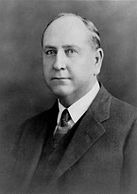| ||||||||||||||||||||||||||||||||||
All 50 seats in the Western Australian Legislative Assembly | ||||||||||||||||||||||||||||||||||
|---|---|---|---|---|---|---|---|---|---|---|---|---|---|---|---|---|---|---|---|---|---|---|---|---|---|---|---|---|---|---|---|---|---|---|
| ||||||||||||||||||||||||||||||||||
| ||||||||||||||||||||||||||||||||||
Elections were held in the state of Western Australia on 8 April 1933 to elect all 50 members to the Legislative Assembly. The one-term Nationalist-Country coalition government, led by Premier Sir James Mitchell, was defeated by the Labor Party, led by Opposition Leader Philip Collier.
The election occurred at the height of the Great Depression, and was notable for four reasons. Firstly, it is, to date, the only Western Australian election at which a sitting Premier has been defeated in his own seat, with Sir James Mitchell losing his Northam seat to Albert Hawke. It has also been the only election (apart from the ministerial by-elections in December 1901) where over half a Ministry have been defeated at an election—apart from Mitchell, Hubert Parker, John Scaddan and John Lindsay all lost their parliamentary seats. Secondly, three future Premiers, Frank Wise (1943–1945), Albert Hawke (1953–1959) and John Tonkin (1971–1974), were elected to Parliament on the same day. Thirdly, it was held on the same day as the secession referendum, which was passed by 68% of voters despite their choice of a party to lead the State who had persistently opposed secession. Finally, the Nationalists fell to third place at the election in terms of seats, meaning that the Country Party, who had more seats in parliament, were able to name the Opposition Leader until Labor's eventual defeat in the 1947 election. This result was in part possible due to the malapportionment in the Western Australian parliament which created more seats in mining areas, where the Labor Party was dominant, and in agricultural areas, where the Country Party was dominant.
Two changes of affiliation had occurred in the previous term, which resulted in the Country Party increasing their parliamentary strength in the Assembly to 12 members. Arnold Piesse, who as an independent had defeated former Country Party leader Alec Thomson in his Katanning seat at the 1930 election, joined the Country Party, as did Richard Sampson, the long-serving member for Swan who had been elected a Nationalist.

